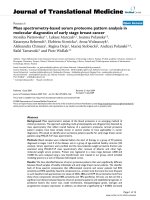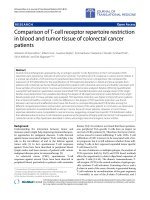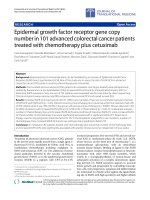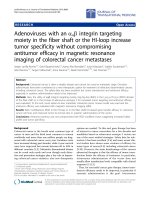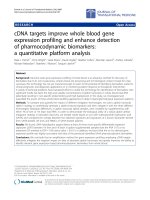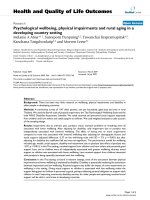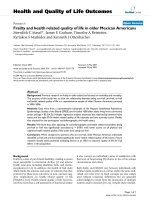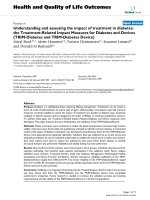báo cáo hóa học:" Non-invasive interactive neurostimulation (InterX™) reduces acute pain in patients following total knee replacement surgery: a randomised, controlled trial" potx
Bạn đang xem bản rút gọn của tài liệu. Xem và tải ngay bản đầy đủ của tài liệu tại đây (2.59 MB, 11 trang )
Nigam et al. Journal of Orthopaedic Surgery and Research 2011, 6:45
/>
RESEARCH ARTICLE
Open Access
Non-invasive interactive neurostimulation
(InterX™) reduces acute pain in patients
following total knee replacement surgery:
a randomised, controlled trial
Ashok K Nigam1, Drena M Taylor1 and Zulia Valeyeva2*
Abstract
Background: Adequate post-operative pain relief following total knee replacement (TKR) is very important to optimal
post-operative recovery. Faster mobilisation and rehabilitation ultimately results in optimum recovery outcomes, but
pain is often the limiting factor. This study evaluates the potential clinical benefit of the InterX neurostimulation device
on pain reduction and rehabilitative outcome.
Methods: A clinical trial under the Hywel Dda Clinical Audit Committee to validate the clinical benefit of Noninvasive Interactive Neurostimulation (NIN) therapy using the InterX device was performed in patients
undergoing TKR. 61 patients were randomised to treatment groups in blocks of two from the Theatre Operation
List. The control group received the standard hospital course of pain medication and rehabilitation twice daily
for 3 post-op days. The experimental group received 8 sessions of NIN therapy over 3 post-op days in addition
to the standard course received by the Control group. Pain and range of motion were collected as the primary
study measures.
Results: Sixty one subjects were enrolled and randomised, but 2 subjects (one/group) were excluded due to
missing data at Baseline/Final; one subject in the InterX group was excluded due to pre-existing rheumatoid pain
conditions confounding the analysis.
The experimental group pre- to post-session Verbal Rating Scale for pain (VRS) showed that NIN therapy
consistently reduced the pain scores by a mean of 2.3 points (SE 0.11). The NIN pre-treatment score at Final was
used for the primary ANCOVA comparison, demonstrating a significantly greater cumulative treatment effect of a
mean 2.2 (SE 0.49) points pain reduction (p = 0.002). Control subjects only experienced a mean 0.34 (SE 0.49) point
decrease in pain. Ninety degrees ROM was required to discharge the patient and this was attained as an average
despite the greater Baseline deficit in the InterX group. Eight control patients and three experimental patients did
not achieve this ROM.
Conclusions: The results clearly demonstrated the clinical benefit of NIN therapy as a supplement to the standard
rehabilitation protocol. The subjects receiving InterX fared significantly better clinically. Within a relatively short 3day period of time, patients in the experimental group obtained the necessary ROM for discharge and did it
experiencing lower levels of pain than those in the control group.
* Correspondence:
2
InterX Clinic Cheltenham, Maple House, Bayshill Rd, Cheltenham, Glouc, UK
Full list of author information is available at the end of the article
© 2011 Nigam et al; licensee BioMed Central Ltd. This is an Open Access article distributed under the terms of the Creative Commons
Attribution License ( which permits unrestricted use, distribution, and reproduction in
any medium, provided the original work is properly cited.
Nigam et al. Journal of Orthopaedic Surgery and Research 2011, 6:45
/>
Background
Adequate post-operative pain relief following total knee
replacement (TKR) is very important to optimal postoperative recovery[1]. The faster that mobilisation and
rehabilitation can progress, the better the ultimate outcome will be[2]. Adequate pain control postoperatively
should allow earlier patient mobilisation with the aim of
increasing strength and proprioception and decreasing
the incidence of the development of thromboembolism,
however side effects of pain medication have been
shown to increase the incidence of thromboembolism
[3]. In complicated cases, prolonged immobility due to
pain can cause the development of muscular contractures or atrophy that eventually cause the development
of long term functional impairments[4]. Unfortunately,
there are very few pain management options available
that can provide a treatment that is both non-invasive
and without side effects.
Current pharmaceutical pain relief options for TKR
pain have limitations due to associated side effects,
often requiring additional treatment for them[5]. Sideeffects of the opiate pain medication include lethargy,
sedation, respiratory depression, nausea, vomiting,
numbness, weakness, urinary retention, hypotension[6]
and digestive discomfort, including gastroparesis and
constipation[7]. Opioids may also alter mood negatively
and/or induce euphoria. The side effects of non-steroidal anti-inflammatory agents (NSAIDS) include gastric
upset, sometimes predisposing symptoms leading to
peptic ulcers. COX-2 inhibitors have been found to
increase risk of heart attack while overdoses can lead to
liver damage[8]. Navigating these side effects amongst
the co-morbidities and potential drug interactions with
concurrent medications in the elderly population is typically problematic.
Historically, electrical stimulation modalities, such as
transcutaneous electrical nerve stimulation (TENS), have
been used to manage pain and facilitate recovery from
various traumatic conditions[9-12]. In general, the drawbacks of using TENS for this application is that the
devices use non-specific current dispersed through predominantly large electrode pads, the amplitude of the
stimulation is limited by the risk of muscle contraction
and the current density is limited by the recommended
safe minimum size of the electrodes[13]. A conductive
medium (gel), either separately applied or as part of a
pre-gelled electrode, is also needed to protect the
patient from uncomfortable variations in current that
are caused as the tissue responds to the stimulation.
Research has shown mixed results in the post-surgical
application of TENS. The Bandolier, evidence-based
health care web site highlighted a systematic review of
TENS and stated: “Clinical bottom line: TENS is not
effective in the relief of post-operative pain. Patients
Page 2 of 11
should be offered effective methods of pain relief” (Bandolier, 2000). Conversely, Bjordal and Johnson (2003)
showed that the clinical results can be significantly
improved if optimal parameters and dosage are used.
However, only one of the studies in that review related
to TKR. A systematic review of the TENS application
on TKR concluded “that there is no utility for TENS in
the post-operative management of pain after knee
arthroplasty”[14]. As such, TENS is rarely used in this
setting, despite there being a significant need for
improved pain control for patients and a belief that the
next biggest development in TKR may be a pain relief
modality[15].
There are a number of factors that may contribute to
the lack of efficacy of TENS in this application. Literature has shown that the variables of electrode placement
[16-18], frequency of stimulation[19-21] and amplitude/
waveform[22-24] all have an impact on clinical outcomes. Additionally, accommodation of nerves to stimulation during single treatments or following long-term
use of an electrical modality has been reported[21]. In
most electrical stimulation applications, the frequency
and waveform component of stimulation has been the
least understood and least manipulated parameter of stimulation. Electrical stimulation typically has been limited to setting sweeping frequencies, or establishing a
ramping or random burst pattern while the amplitude
of stimulation also plays a very important role. Even one
parameter setting that is not optimally set may significantly reduce the efficacy of the treatment. Indeed, it is
now understood that combining optimal treatment parameters can significantly improve clinical efficacy[22].
There is increasing evidence that successful optimization of electrode position, amplitude and frequency
parameters in a dynamically changing pattern may well
be the key critical to successful therapeutic outcomes
[25-27]. The InterX is a device that provides such noninvasive interactive neurostimulation (NIN), optimizing
all three stimulation parameters in a high amplitude,
high density manner without penetrating too deeply into
the tissue and without soliciting uncomfortable muscle
contractions. The depth of penetration of electrical stimulation is proportional to both the electrode size and
the distance between the electrodes. The closer electrodes are placed and the smaller the surface area, the shallower the depth of penetration[28]. If the stimulation
does not reach the depth of the muscle, the amplitude
is not restricted by muscle contraction. Thus, a device
that delivers stimulation through an array of small, closely spaced electrodes will be capable of delivering
higher amplitudes and therefore higher current densities
than a device using larger electrodes[29]. This is a critical technological advancement of the InterX as research
has demonstrated how important using higher
Nigam et al. Journal of Orthopaedic Surgery and Research 2011, 6:45
/>
amplitudes are to getting better clinical results[22,24]. In
fact, it is current densities, which are the effective, measure of stimulus[30] in much the same way that pressure, not force, is the effective measure of manual
therapy. Figure 1a shows a hypothetical illustration of
the path of stimulation based upon known science when
comparing two such models. The actual path of stimulation is determined by a number of factors and is hard to
map precisely due to localised differences in tissue
impedance[28]. The circuitry of the InterX allows the
waveform to adjust as the impedance of the treatment
area changes as the electrode is moved over the skin or
in response to stimulation. The electrode does not
require conductive gels, but is placed directly onto the
skin surface. Because the human nervous system is
adaptive, therapy sessions using the InterX rapidly vary
the stimulation parameters interactively (Figure 1b) to
prevent physiological accommodation, directing stimulation to optimal treatment points as well as protecting
the skin from damage. These changes occur automatically as skin impedance changes in response to the electrical stimulation, which is caused by a combination of
increased Galvanic Skin Response and electro-osmosis
[28,31]. So there appears to be some scientific merit to
claim by the manufacturers of InterX that the interactive
technology supports a particular application that is
aimed at optimizing parameters, which individually have
been shown to elicit greater clinical benefit.
The InterX device operates by scanning the tissue to
determine its impedance and to use the electrical characteristic of the skin to identify and target optimal treatment points. As stimulation is performed, the
impedance of the skin under the electrode changes and
is sensed by the device through the completed electrical
circuit which in turn automatically varies the waveform
parameters. Different preset stimulation patterns are
selected in subsequent therapy sessions to prevent physiological accommodation and each of these presets
automatically delivers a varying frequency to ensure
Page 3 of 11
optimal effects[20]. The presets in this study varied the
frequency from 15-360 pulses per second using a mixture of burst, variable and amplitude modulated
parameters.
The handheld application of NIN has previously been
shown to significantly reduce pain, medication intake
and inflammation while also increasing range of motion
following hip and ankle surgery[25,26]. In this study, the
Flexible Array Electrode was used on post-operative
TKR patients to treat their post-operative pain in combination with pharmaceutical analgesia and an aggressive rehabilitation protocol. This configuration of
electrodes allows for tissue impedance scanning to be
performed automatically. Each flexible array is comprised of nine electrodes; five of which are positive and
four of which are negative. In this study four flexible
arrays were used simultaneously which means 36 active
electrodes (20 positive and 16 negative) were in contact
with the skin around the knee(Figure 2). Ohms Law
describes how electrical current will take the path of
least resistance, so greater current density is delivered to
these points of low impedance/resistance, as opposed to
points of high impedance, by virtue of the electrode
array configuration. The low impedance on the skin corresponds with myofascial trigger points and acupuncture
points, which also have a high correlation with major
nerve branches, and are treatment points which will
respond best to electrical stimulation[32,33].
The objective of this investigation was to observe
whether greater post-operative pain relief and range of
motion (ROM) could be obtained by using the InterX
1000 device and Flexible Array Electrodes when combined with standard in-hospital rehabilitation protocols
in patients undergoing primary TKR surgery as compared to standard in-hospital rehabilitation methods
alone. Primary study endpoints (pain severity and knee
range of motion (ROM)) would ideally show a reduction
in pain severity and greater ROM in the InterX treatment group. Secondary endpoints (pain medication use
Figure 1 A) Current Density B) Interactive Waveform Figure 1a - Current amplitude and density: TENS compared to InterX. Figure 1b Interactive waveform.
Nigam et al. Journal of Orthopaedic Surgery and Research 2011, 6:45
/>
Figure 2 Flexible array and device placement on operated leg.
and signs of inflammation) could result in a reduction in
medication use and in knee joint inflammation. Circumferential measures of the knee were taken to try to
demonstrate any possible changes in signs of inflammation. There is controversy about the reliability of this
measure but we felt there was enough evidence to
include this in the study as it has been used recently
along with both skin temperature and inflammatory biomarkers in patients (other signs of inflammation that
could not be realistically included in this study)[34,35].
Methods
This randomised, controlled, prospective study was conducted under the Hywel Dda Clinical Audit and Risk
Committee as it was performed to demonstrate the efficacy of a recognized technology on a new population of
patients. The clinical audit passed ethics review through
the Audit and Risk Committee. All subjects signed
informed consent. The control group received the standard in-hospital rehabilitation protocol while the experimental group received standard in-hospital
rehabilitation plus eight sessions of NIN therapy. Subjects were randomised to treatment group by the Theatre Operation List whereby subjects were randomly
assigned treatment group by the order in which they
were operated, alternating treatment group assignment
in blocks of two.
61 subjects were enrolled into the study following
elective total knee joint replacement from the orthopaedic clinic in the catchment area of Prince Philip Hospital, Carmarthenshire NHS Trust in Wales, UK. Surgery
was performed using two main types of knee implant
(cruciate retaining and cruciate sacrifice). Inclusion
Page 4 of 11
criteria specified that patients were to be 50-80 years of
age with radiographic evidence of joint disease in at
least 2 of the 3 knee compartments (including patellofemoral disease) who were scheduled for elective TKR.
Subjects were to have no associated neurological deficit,
sensory loss, paraesthesia, or hyporeflexia. Subjects were
to have a clinically significant functional limitation (limited mobility and/or instability of the knee joint) and
diminished quality of life prior to TKR. Additionally,
subjects had to be willing to abide by the protocol and
treatment schedule and sign informed consent. Subjects
with local or systemic infections, medical conditions
that substantially increase the risk of serious peri-operative complications or death were excluded from the
study. Subjects with implanted neurostimulators, insulin
pumps, and/or cardiac pacemakers were excluded due
to the incompatibility of treatment with an electrical
nerve stimulator. Subjects with epilepsy/seizure, dementia or cognitive disorders, pregnancy, psychiatric disease,
active tumour or cancer, fracture or dislocation, or at
substantial risk of venous thrombosis were also excluded
from the study. Signs of venous thrombosis like redness
and pain in the lower leg usually become evident within
72 hrs of surgery if they are going to occur. If the Physician saw any of these signs then treatment with the
InterX was to be halted.
Subjects had standard operative anaesthesia to include
general anaesthesia with either spinal anaesthesia or
with femoral nerve block during the procedure. The
nerve block was a single shot using morphine with
doses ranging from 150-250 mcg. Post-operatively, pain
was to be mediated from surgery to Day 2 by patient
controlled analgesia (PCA) morphine (1 mg/mL) strictly
monitored by a nurse, diclofenac suppositories (Volterol) and acetaminophen (Paracetamol). After 48 hrs,
patients were stepped down to codeine with acetaminophen (Cocodamol) and diclofenac suppositories (Volterol) plus oral morphine for breakthrough pain. The
medication was offered to patients and provided on an
as needed basis (prn).
All subjects were followed for three days in-hospital
prior to discharge to home. While in-hospital, the subjects underwent in-hospital rehabilitation exercises twice
daily to include the following. On day one, subjects are
transferred to a chair and try walking with a walking
frame and they perform ROM exercises. On day two,
subjects perform ROM exercises, walking with a frame
and then walking with support using canes. On day
three, subjects go to occupational therapy and do stair
climbing, mimic getting in and out of a car, and walk
with cane support. The goal is to get to 90° flexion.
Subjects randomised to the experimental group
received NIN therapy according to the following schedule: Day 0 (0-24 hrs post-op), no treatment due to
Nigam et al. Journal of Orthopaedic Surgery and Research 2011, 6:45
/>
bandaging; Day 1 (24-48 hrs post-op), two InterX treatments of twenty minutes each using Preset 4 at approximately 1 pm and 4 pm; Day 2 (48-72 hrs post-op), three
InterX treatments of 20 minutes each using Preset 4
(approx. 9 am; 1 pm and 4 pm); Day 3 (72-96 hrs postop), three InterX treatments of 20 minutes each using
Preset 1 (approx. 9 am; 1 pm and 4 pm). Baseline measures are those taken on Day 1 at approximately 1 pm
(prior to NIN therapy for the experimental group). Final
measures are those taken on Day 3 at approximately 4
pm prior to the final treatment.
NIN therapy was delivered via two InterX 1000™
devices, each with a Dual Flexible Array (Figure 2). Each
array contains nine electrodes so a total of 36 electrodes
are in contact with the skin around the knee. One pair
of arrays was positioned just superior to the patella and
one just inferior to the patella, with the electrode arrays
positioned on the lateral and medial surfaces of the
knee. One device delivered stimulation to the arrays on
the medial side and the other device delivered stimulation to the arrays on the lateral side. The electrodes
were directly in contact with the skin without conductive media. Preset 1 or 4 were used on the device and
they cycled through various parameters for the duration
of the 20-minute application. Preset 1 delivered 30-120
pulses per second (PPS); 15-60 PPS and 15 PPS. Preset
4 delivered 90-360 PPS in a variable burst pattern; 30120 PPS; 240 PPS in a burst pattern and 3:1 amplitude
modulation at 120 PPS. The amplitude was increased by
the nurse practitioner to a level that was strong but
comfortable tingling to the patient and all four arrays
were used at the same time.
In the initial version of the protocol, the study measurements were assessed at each time point. However,
because of the time involved in study measurement collection imposed on the nursing/rehabilitation routines,
the protocol was amended to collect ROM and knee circumference data only at the first (Baseline) and last
(Final) study time period. VRS was recorded at every
treatment and medication was recorded as taken. The
primary study variables were designated as the VRS and
ROM; secondary study measures included the total daily
pain medication taken and knee circumference. Study
measurements were taken at 9 am, 1 pm and 4 pm for
the control group, and just prior to and following NIN
therapy administration at those same times for the
experimental group.
Verbal Rating Scale
Subjects verbally rated the intensity of their knee pain
using an 11-point numeric scale (0 = “no pain"; 10 =
“worst pain possible”). This scale, similar to the Visual
Analogue Scale (VAS), has demonstrated validity and
reliability[36]. At Baseline, all subjects were asked to
Page 5 of 11
rate the intensity of their current pain with the knee in
active flexion. Prior to and following each application of
InterX, experimental group subjects rated their current
pain with the knee in active flexion. Patients were
encouraged to flex their knee as far as they could. Control subjects had only a single measurement taken twice
on the first day, and three times per day thereafter at
approximately the same time of day as the experimental
group was measured.
Range of Motion
Knee flexion was measured by the nurse using a standard goniometer (20 cm Jamar-E-Z by Physiomed). At
Baseline and Final, all subjects were measured. Experimental group subjects were measured pre- and posttreatment at each time point. Control subjects had only
a single measurement at each time point. Patients were
seated and asked to actively flex their knee as far as
pain would allow. This flexion was then measured by
the nurse practitioner.
Medication Log
The dose and frequency of all pain medications were
recorded daily for all patients in mg for PCA morphine
use and for diclofenac suppositories, and pill counts for
acetaminophen, and codeine with acetaminophen using
standardized dosage forms.
Inflammation/Oedema
The circumferential girth at 2 inches above the knee of
both the affected and unaffected knees was measured.
The un-operated knee measurement was subtracted
from the operated knee measurement as a possible indicator of signs of inflammation of the operated knee.
These measures were made at Baseline and Final time
points for all patients.
Sample Size Calculation
The trial’s sample size was determined based on
observed variation in pain scores from earlier studies,
and the investigators’ judgment that a two-point reduction in reported pain (on a scale of 1 to 10) represented
a clinically meaningful result. It is generally accepted
that a 30% reduction of pain in acute cases represents a
clinically meaningful change[37], so a two-point reduction applies to this population of patients who typically
average between 4 and 6 out of 10 on the pain scale following surgery. The study was designed to provide
power of 80% with an alpha level of 0.05, and allowed
for 20% loss to follow-up. Therefore, 30 subjects/group,
60 subjects total, were to be enrolled into the study.
Demographics
Sixty-one subjects signed informed consent and were
enrolled into the study. Two subjects, one in each treatment group, were excluded from the analysis due to
Nigam et al. Journal of Orthopaedic Surgery and Research 2011, 6:45
/>
missing data from either the Baseline or the Final time
point so that calculations regarding differences from
Baseline to Final could not be determined. Additionally,
one subject in the InterX group was determined to have
a pre-existing condition of rheumatoid arthritis that
confounded the data analysis and so she was excluded
post-hoc. Ultimately, 28 subjects in the experimental
group and 30 subjects in the control group are included
in the below analyses (Figure 3).
Table 1 shows the demographic and baseline characteristics of both treatment groups. There was no significant difference between groups with regard to gender or
Figure 3 CONSORT Chart.
Page 6 of 11
age. However, a clinically significant difference between
groups was noted in other parameters. The experimental
group had an average pain score, which was 1.5 points
higher than the control group, bordering on the difference required between groups for the power calculation.
Additionally, there was a statistically significant difference between the two groups in the baseline ROM measurement (p = 0.0005), with a mean ROM for the
InterX group of 45.7 and a mean ROM for the control
group of 60.4. The standard error of the estimated difference between the two groups (15.8) was 4.13 Surprisingly, the difference between the circumferences of the
Nigam et al. Journal of Orthopaedic Surgery and Research 2011, 6:45
/>
Page 7 of 11
Table 1 Patient demographics and baseline
characteristics
Control Group
N = 30
InterX Group
N = 28
Male
15
15
Female
15
13
Average Age (years)
69.3
67.9
Baseline* VRS
4.4
5.9
Pre-op
109.5
110.4
Baseline
60.4
45.7
4.7
3.5
Gender
ROM (degrees)
Baseline* Inflammation (cm)
*Baseline here is defined as the first measurement on Day 1 after the
bandages have been removed.
The groups are clinically significantly different in three variables: Pain (VRS)
was higher in the InterX group; ROM was poorer in the InterX group;
inflammation/oedema was higher in the control group.
affected and un-affected knees was 1.2 cm less in the
InterX group at Baseline than the control (p = 0.03).
Results
Verbal Rating Scale (VRS) Pain Scores
The effect of NIN therapy with the InterX as compared to
control on the change in VRS between the Baseline and
the Final study time periods is presented in (Figure 4). For
the experimental group, the “before therapy” scores were
used in both instances as this seemed to reflect a long-lasting, cumulative effect of NIN therapy vs. a potentially
transient effect following therapy. An analysis of covariance (ANCOVA) was used with the Baseline VRS score
serving as the covariate term. The treatment effect was
highly significant (p = 0.002), with an adjusted mean
change for the InterX group of -2.15 improvement vs. an
adjusted mean change of improvement for the control
group of -0.34. The standard error of the estimated difference between the two groups (1.81) was 0.57.
In Figure 5, the patients’ pain scores at the Final time
point were plotted. 3 subjects (11%) in the InterX pre-
Figure 4 VRS pain scores during joint mobilisation.
Figure 5 Distribution of VRS patient pain scores during flexion
at Final time point. The chart shows the level of pain for each
patient in the Control group and in the InterX group at both preNIN therapy and at post-NIN therapy. At Final post-NIN therapy, 27
of 28 patient had only Mild or No pain (0-3, VRS).
NIN therapy group reported 0 or no pain; 11 subjects
(39%) with mild pain (VRS = 1-3); 13 subjects(46%)
reported moderate pain (VRS = 4-7); 1 subject (4%)
reported severe pain (VRS 8-10). The control group had
no patients with zero pain scores, 14 subjects(47%) with
mild pain; 9(30%), with moderate pain; and 7 (23%) with
severe pain (VRS = 8-10) at Final. The InterX post-NIN
therapy group had 27 of 28 subjects (96%) with none or
mild pain vs. the control group with a total of 14 subjects(47%) reporting only mild pain and no patients
reporting being pain free. Overall, at the Final pre-treatment measure, only three patients in the InterX group
had a higher pain score than at Baseline compared to
thirteen control patients. Post-treatment immediately
prior to discharge, all InterX patients reported a lower
pain score than that Baseline.
A similar analysis was conducted on a subset of
“high pain” patients identified by selecting individuals
with a recorded VRS of 7 or greater for any time period
(Figure 6). The treatment effect for this subset of
patients was highly significant (p = 0.006), with an
adjusted mean pain reduction for the experimental
group of 2.66 point vs. an adjusted mean pain reduction
for the control group of 0.49. The difference between
the two groups was 2.18 (S.E. 0.73). The average worst
pain during the study was 8.4 and 8.5 in the NIN and
control severe pain patients respectively. At discharge,
the control group reported a VRS of 5.9 while the
experimental group reported an average of 3.9 before
the last NIN treatment. Following the last treatment, the
average VRS in the experimental group during knee
Nigam et al. Journal of Orthopaedic Surgery and Research 2011, 6:45
/>
Page 8 of 11
Table 2 Patient medication intake
Medication Intake
The effect of treatment (NIN vs. control) was analysed
on the change in ROM between Baseline and Final (Figure 7). An analysis of covariance was used with the presurgery ROM serving as the covariate term. We found
the covariate term was not significant, so it was dropped
from the final model. The treatment effect was highly
significant, with a mean improvement in ROM for the
experimental group of 45.7° vs. a mean improvement for
the control group of 27.2°. The estimated difference
between the improvement in each group was 18.4° (S.E.
4.29) with the experimental group showing significantly
greater improvement than control (p = 0.0001). The
goal of rehabilitation was to get the subject to 90° flexion prior to discharge. Both treatment groups met this
goal, but the experimental group had a greater deficit to
regain to get there in the same length of time.
Medications
Table 2 shows the daily medication use that was tracked
during the study for PCA, diclofenac suppositories, acetaminophen, codeine with acetaminophen and oral morphine. The oral morphine data was converted to the
equivalent PCA dosage (3:1 ratio of analgesic
P value
9.3%
p = 0.68
315
230
27%
p = 0.28
7.23
7.1
1.8%
p = 0.90
Cocodamol
30/500/per day
ROM
% Difference
29.7
Paracetamol
(# 500 mg pills/day)
flexion was 0.8, which was immediately prior to
discharge.
InterX
32.73
Voltarol
(100 mg/day)
Figure 6 Change in VRS pain scores for severe pain subgroups (VRS > 6). Error bars are Standard Deviation
Control
PCA
(mg/day)
4.47
4.0
10.5%
p = 0.56
effectiveness)[38] and added to the PCA data. Total
medication use was compared between groups. Both
parametric (Student’s t-test) and non-parametric
(Mann-Whitney test) methods were used to individually
analyse the effect of treatment (InterX vs. control) on
total consumption of each of four medications. P-values
for the parametric and non-parametric tests were nonsignificant for all drugs, indicating that there was not a
statistically significant decrease in medication though
there may be clinically significant implications for
patients taking 9% less morphine, nearly 30% less
NSAIDs and 10% less cocodamol. A multivariate test of
differences (MANOVA) between the two treatment
groups for all four medications was performed. The
treatment effect was not significant (p = 0.64) using the
Wilks Lambda statistic.
In retrospect, it is believed that this measure in this
situation was probably an inappropriate measure to
include because the goal of post-operative pain medications in a procedure of this magnitude, is to stay ahead
of the pain and so standard administration of pain medicines at regular intervals are administered by hospital
staff regardless of the subject’s level of pain. It is noteworthy that the experimental group, who started with
higher levels of pain at Baseline, reported lower levels of
pain, or no pain, using the same amount of pain medications as the control group who were reporting no significant relief from pain. It was deemed not possible to
convert the different types of medications into one measure as they included opioids and NSAIDs. So this data
stands as a backdrop to demonstrate that the pain
reduction seen in the experimental group was due to
the NIN treatment and not due any variations in medication intake. It should be noted that the experimental
group did take less medication than the control (see
Table 2), but this failed to show statistical significance.
Inflammation/Oedema
Figure 7 Increase in range of motion during rehabilitation.
Error bars are Standard Deviation. Figures rounded to nearest
degree.
The effect of treatment (NIN vs. control) was analysed
on the change in inflammation (measured as the difference between circumferences of the non-operated and
operated knees) between the Baseline and Final. An analysis of covariance was used with the inflammation measured during the Baseline serving as the covariate term.
Nigam et al. Journal of Orthopaedic Surgery and Research 2011, 6:45
/>
The treatment effect was not significant (p = 0.44), with
an adjusted mean change for the experimental group of
1.11 cm vs. an adjusted mean change for the control
group of 1.59 cm. The standard error of the estimated
difference between the two groups (0.48) was 0.67. Note
that both groups experienced an increase in the circumference of the affected knee following the surgery as is
normal for this type of invasive procedure. The difference between treatment groups at Final is consistent
with the difference seen at Baseline. However, it should
be noted that the experimental group took on average
27% less NSAIDs. The average change in knee circumference was very small and almost within the normal
variations expected with repeated measures, which may
indicate that this circumferential method in this study
may not have been a reliable way to measure changes in
inflammation[39]. So while the experimental group were
discharged with significantly less circumferential differences between the affected and unaffected knees (p <
0.05), it is impossible to draw any conclusion from this
data point due to the complexity of this outcome and
the variations in NSAID intake between the groups.
Discussion
This study was undertaken as an audit of the Hywel
Dda NHS Trust in Wales to validate the clinical benefit
of NIN therapy as a supplemental rehabilitative therapy
following TKR. The hospital currently uses NIN therapy
as a standard course of therapy in the chronic pain
clinic. The results of this study clearly demonstrated the
clinical benefit of NIN therapy with the InterX device as
a supplement to the standard in-house rehabilitative
protocol for patients following TKR. By random assignment to treatment group, subjects with more severe
pain and more ROM-restricted were placed in the
InterX group. Within a relatively short 3-day period of
time, patients in the InterX group obtained the necessary ROM for discharge and did it experiencing significantly reduced levels of pain compared to those in the
control group.
In making conclusions regarding the effectiveness of
electrical stimulation to counteract pain, several relevant
ideas have been discussed by Bjordal [22] in the metaanalysis of TENS used to reduce post-operative analgesic consumption. First, is the idea that TENS is effective
only if it used optimally and that amplitude and frequency appear to be the most important variables. Secondly, that TENS is only effective for partial pain relief
whereas analgesic pharmaceuticals have the potential for
complete pain relief, though side effects often mitigate
this. Typically, TENS has been considered effective only
if the supplemental use of TENS results in a reduction
of analgesic consumption without increased pain scores.
In Bjordal’s article, it is suggested that a positive
Page 9 of 11
outcome also occurs when there is a decrease in pain
scores, but the analgesic consumption (at a tolerable
level) is maintained. The author also mentions that the
best treatment effects were observed using the higher
frequencies of TENS at 85 Hz and at an amplitude of >
15 mA or a strong sensation to the patient.
Within this study, the latter scenario was observed.
Subjects here experienced greater pain relief on tolerable pain medication regimens. The greater pain relief
seen in this study allowed the patients to push harder
in rehabilitation to reach the discharge criteria since
the InterX treatment group was clinically more
severely hampered with pain and ROM restrictions at
Baseline. It should be noted that the InterX was used
at a variable frequency covering the optimal range suggested by Bjordal et al and also at an amplitude in the
range of > 40 mA[29]. It is of interest, that after the
study was complete some of the severe patients in the
control group received NIN therapy to bring their pain
down so that they could engage in the rehabilitation
process. Medication alone was not sufficient, without
inhibitory side effects, to reduce pain for these
patients.
Evidence shows that InterX NIN therapy probably
activates the gate control mechanism of pain control,
but due to the short treatments, long-lasting effects and
cumulative reductions in pain reported by patients, gate
control probably is not the primary mechanism of pain
relief[25-27]. InterX NIN therapy targets low impedance
areas of the body (trigger points)[40]. It is believed that
increases in blood flow and sweat secretion account for
the changes in skin impedance[40]. As the skin is stimulated, its impedance changes[28]. The InterX rapidly
modifies the waveform and amplitude in response to
these impedance changes which allows for a significantly
greater concentration (current density) of stimulation
without risking harm to the skin. It is hypothesized that
the delivery of high amplitude stimulation to multiple
treatment points in this way enhances the pain relief
achieved as compared to lower amplitude stimulation
delivered only over the pain site. The mechanism of
pain relief for this type of cutaneous stimulation is suggested to include both segmental and descending inhibition[23]. More recently it has been shown that NIN
therapy activates significantly greater production of certain cytokines and genes than TENS which may optimize the inflammatory process and reduce pain. NIN
stimulates the production of Adenosine Triphosphate
(ATP)[41] which would have both an anti-inflammatory
effect as well as reduce pain segmentally[42]. The inability of TENS technology to deliver such high current
densities so specifically may explain why TENS clinical
studies in this application have been unsuccessful in the
past[14]. By reducing pain during movement prior to a
Nigam et al. Journal of Orthopaedic Surgery and Research 2011, 6:45
/>
rehabilitation session the patient may be able to perform
exercises with greater ease, work harder, and have less
discomfort while exercising which has potential benefits
for a population of patients who need to return to function as quickly as possible[15].
Conclusions
The results of this study clearly demonstrated that the
delivery of NIN through the Flexible Array Electrode is
effective for the management of pain in this population
of patients, supporting previous literature pertaining to
the handheld application of NIN in the post-surgical
setting. The InterX is designed to optimize treatment
point location, amplitude and frequency to ensure better
clinical results and this technological aspect is maintained in this application. The clinical benefit of NIN
therapy with the InterX device as a supplement to the
standard in-house rehabilitative protocol allows patients
suffering pain to regain function quicker, especially if
their pain levels are particularly high. Even though subjects with more severe pain and more ROM-restriction
were randomly assigned to the InterX group, the subjects receiving NIN therapy with InterX fared much better clinically with significantly reduced pain levels and
improvements in ROM compared to control subjects.
The implications of these findings are that patients suffering severe pain following TKR struggle to get sufficient relief from the standard of care of medications and
that the inclusion of NIN therapy into the standard of
care will offer greater and more consistent pain control,
without the need for increased medication even with the
worst cases.
List of Abbreviations
ANCOVA: analysis of Covariance; cm: centimetres; MANOVA: multivariate test
of differences; NSAIDS: nonsteroidal anti-inflammatory drugs; NIN therapy:
non-invasive interactive neurostimulation; PCA: patient controlled analgesia;
ROM: range of motion; TENS: transcutaneous electrical nerve stimulator; TKR:
total knee replacement; VRS: verbal rating scale
Acknowledgements
We thank Kathy L. McDermott who provided medical writing services on
behalf of Neuro Resource Group Inc. and Paul Magee for providing all the
technical information about the InterX.
Author details
1
Prince Philip Hospital, Carmarthenshire NHS Trust, Mawr Dafen, Llanelli, UK.
2
InterX Clinic Cheltenham, Maple House, Bayshill Rd, Cheltenham, Glouc, UK.
Authors’ contributions
AN was the principle investigator and oversaw the implementation of the
protocol. DT performed all treatments, measurements and data collection.
ZV assisted in the development of the study protocol only. All authors have
read and approved the final publication article.
Competing interests
The author(s) AN and DT declare that they have no competing interests.
Author ZV is a paid consultant for Neuro Resource Group and holds shares
in the company, although she was not involved in collection or
interpretation of data.
Page 10 of 11
Received: 27 October 2010 Accepted: 24 August 2011
Published: 24 August 2011
References
1. Skinner HB: Multimodal acute pain management. Am J Orthop 2004, 33(5
Suppl):5.
2. Ranawat CS, Ranawat AS, Mehta A: Total knee arthroplasty rehabilitation
protocol: what makes the difference? J Arthroplasty 2003, 18(3 Suppl
1):27.
3. Berend KR, Lombardi AV, Mallory TH, Dodds KL, Adams JB: Ileus following
total hip or knee arthroplasty is associated with increased risk of deep
venous thrombosis and pulmonary embolism. The Journal of Arthroplasty
2004, 19(7, Supplement 2):82-86.
4. Peters CL, Shirley B, Erickson J: The effect of a new multimodal
perioperative anesthetic regimen on postoperative pain, side effects,
rehabilitation, and length of hospital stay after total joint arthroplasty. J
Arthroplasty 2006, 21(6 Suppl 2):132.
5. Wheeler M, Oderda GM, Ashburn MA, Lipman AG: Adverse events
associated with postoperative opioid analgesia: a systematic review. J
Pain 2002, 3:159-180.
6. Zhao SZ, Chung F, Hanna DB, Raymundo AL, Cheung RY, Chen C: Doseresponse relationship between opioid use and adverse events after
ambulatory surgery. J Pain and Symptom Management 2004, 28:35-46.
7.
Cancer Control 1999, 6(2):198-204, © 1999 H. Lee Moffitt Cancer Center and
Research Institute, Inc.
8. Rainsford KD: Profile and mechanisms of gastrointestinal and other side
effects of nonsteroidal anti-inflammatory drugs (NSAIDs). The American
Journal of Medicine 1999, 107(6, Supplement 1, 13):27-35.
9. Bayindir O, Paker T, Akpinar B, Erenturk S, Askin D, Aytac A: Use of
transcutaneous electrical nerve stimulation in the control of
postoperative chest pain after cardiac surgery. J Cardiothorac Vasc Anesth
1991, 5(6):589-91.
10. Conn IG, Marshall AH, Yadav SN, Daly JC, Jaffer M: Transcutaneous
electrical nerve stimulation following appendicectomy: the placebo
effect. Ann R Coll Surg Engl 1986, 68(4):191-2.
11. Walker RH, Morris BA, Angulo DL, Schneider J, Colwell CW: Postoperative
use of continuous passive motion, transcutaneous electrical nerve
stimulation, and continuous cooling pad following total knee
arthroplasty. J Arthroplasty 1991, 6(2):151-6.
12. Ordog GJ: Transcutaneous electrical nerve stimulation versus oral
analgesic: A randomized double-blind controlled study in acute
traumatic pain. The American Journal of Emergency Medicine January 1987,
5(1):6-10.
13. EMPI Inc: Instruction Manual for the Empi EPIX VTTM TENS Device. Empi
599 Cardigan Road St Paul, Minnesota 55126-4099 USA .
14. Breit R, Van der Wall H: Transcutaneous electrical nerve stimulation for
postoperative pain relief after total knee arthroplasty. J Arthroplasty 2004,
19(1):45-48.
15. Ranawat AS, Ranawat CS: Management and accelerated rehabilitation for
total hip and total knee arthroplasty. Journal of Arthroplasty 2007,
22(7):12-15.
16. Chesterton LS, Foster NE, Wright CC, Baxter D, Barlas P: Effects of TENS
frequency, intensity and stimulation site parameter manipulation on
pressure pain thresholds in healthy human subjects. Pain 2003, 106(12):73-80.
17. Leica S, Claydon L, Chesterton LS, Barlas P, Sim J: Effects of simultaneous
dual-site TENS stimulation on experimental pain. European Journal of Pain
2008, 12(6):696-704.
18. Somers D, Clemente FR: TENS for the management of neuropathic pain:
The effects of frequency and electrode position on prevention of
allodynia in a rat model of CRPS type II. Phys Ther 2006, 86(5):698-709.
19. Han JS: Acupuncture: neuropeptide release produced by electrical
stimulation of different frequencies. Trends in Neurosciences 2003, 26(1).
20. Hamza MA, White PF, Ahmed HE, Ghoname EA: Effect of the frequency of
transcutaneous electrical nerve stimulation on the postoperative opioid
analgesic requirement and recovery profile. Anesthesiology 1999,
91:1232-1238.
21. DeSantana JM, Santana-Filho VJ, Sluka KA: Modulation Between High- and
Low-Frequency Transcutaneous Electric Nerve Stimulation Delays the
Development of Analgesic Tolerance in Arthritic Rats. Arch Phys Med
Rehabil 2008, 89:754-760.
Nigam et al. Journal of Orthopaedic Surgery and Research 2011, 6:45
/>
22. Bjordal JM, Johnson MI, Ljunggreen AE: Transcutaneous electrical nerve
stimulation (TENS) can reduce postoperative analgesic consumption. A
meta-analysis with assessment of optimal treatment parameters for
postoperative pain. European Journal of Pain 2003, 7:181-188.
23. Sluka K, Walsh D: TENS: Basic Science Mechanisms and Clinical
Effectiveness. Journal of Pain 2003, 4(3):109-121.
24. Melzack R: Prolonged relief of pain by brief, intense transcutaneous
somatic stimulation. Pain 1975, 1:357-373.
25. Gorodetskyi IG, Gorodnichenko AI, Tursin PS, Reshetnyak VK, Uskov ON:
Non-invasive interactive Neurostimulation in the post-operative recovery
of patients with a trochanteric fracture of the femur. J Bone Joint Surg
[Br] 2007, 89-B:1488-94.
26. Gorodetskyi IG, Gorodnichenko AI, Tursin PS, Reshetnyak VK, Uskov ON: The
effects of non-invasive, interactive Neurostimulation on pain and edema
during post-surgical rehabilitation following internal fixation of unstable
bi-malleolar ankle fractures. J Foot Ankle Surg 2010, 49:432-437.
27. Maale G: The effect of the InterX 5000 on pain reduction in the severe
chronic orthopedic patient. International congress of technology in
arthroplasty, Kyoto; 2005.
28. Grimnes S, Martinsen O: Bioimpedance and Bioelectricity Basics., Second
2008, 190-191, ISBN: 978-0-12-374004-5.
29. Format Medical Device Management Ltd & Magee P: Neuro Resource
Group, Inc., VV002, Clinical Investigation, InterX 5000, Technical File for
CE Mark. Last accessed February 2011.
30. Reilly P: Applied Bioelectricity: From Electrical Stimulation to
Electropathology. Springer; 1998, 129-131, ISBN 0-387-984407-0.
31. Grimnes S: Skin impedance and electro-osmosis in the human epidermis.
Med Biol Eng Comput 1983, 21:739-749.
32. Colbert A, Yun J, Larsen A, Edinger T, Gregory W, Thong T: Skin impedance
measurements for acupuncture research: development of a continuous
recording system. Evid Based Complement Alternat Med 2008, 5:443-50.
33. Walsh D: Transcutaneous electrical nerve stimulation. In Acupuncture and
Related Techniques in Physical Therapy. Edited by: Hopwood V, Lovesey M,
Mokone S. New York, Churchill Livingstone; 1997:111-18.
34. Martin F, Martinez V, Mazoit JX, Bouhassira D, Cherif K, Gentili ME, Piriou P,
Chauvin M, Fletcher D: Antiinflammatory effect of peripheral nerve blocks
after knee surgery: clinical and biologic evaluation. Anesthesiology 2008,
109(3):484-490.
35. Martinez V, Fletcher D, Bouhassira D, Sessler DI, Chauvin M: The evolution
of primary hyperalgesia in orthopedic surgery: quantitative sensory
testing and clinical evaluation before and after total knee arthroplasty.
Anesth Analg 2007, 105(8):15-21.
36. Cork RC, Isaac I, Elsharydah A, Saleemi S, Zavisca F, Alexander L: A
Comparison Of The Verbal Rating Scale And The Visual Analog Scale For
Pain Assessment. The Internet Journal of Anesthesiology 2004, 8(1).
37. McQuay HJ, Barden J, Moore RA: Clinically important changes-what’s
important and whose change is it anyway? J Pain Symptom Manage 2003,
25(5):395-6.
38. Pereira J, Lawlor P, Vigano A, Dorgan M, Bruera E: Equianalgesic Dose
ratios for Opioids: a critical review and proposals for long term dosing. J
of Pain and Symp Mgt 2001, 22(2):672-687.
39. Jakobsen TL, Christensen M, Christensen SS, Olsen M, Bandholm T:
Reliability of knee joint range of motion and circumference
measurements after total knee arthroplasty: does tester experience
matter? Physiother Res Int 2010, 15(3):126-34.
40. Shultz SP, Driban JB, Swanik CB: The evaluation of electrodermal
properties in the identification of myofascial trigger points. Arch Phys
Med Rehabil 2007, 88:780-4.
41. Clark JF, Magee P: Changes in lymphocyte metabolism, gene expression
and cytokine production following transdermal interactive
neurostimulation: indicators of connective tissue healing and antiinflammatory activity. Department of Neurology, University of Cincinnati, OH
45267-0536, Presented as a poster at the International Association for the
Study of Pain (IASP) Montreal, Canada; 2010.
42. Goldman N, Chen M, Fujita T, Xu Q, Peng W, Liu W, Jenson T, Pei Y,
Wang F, Han X, Chen JF, Schnermann J, Takano T, Bekar L, Tieu K,
Nedergaard M: Adenosine A1 receptors mediate local anti-nociceptive
effects of acupuncture. Nature Neuroscience 2010, 13:883-888.
Page 11 of 11
doi:10.1186/1749-799X-6-45
Cite this article as: Nigam et al.: Non-invasive interactive
neurostimulation (InterX™™) reduces acute pain in patients following
total knee replacement surgery: a randomised, controlled trial. Journal
of Orthopaedic Surgery and Research 2011 6:45.
Submit your next manuscript to BioMed Central
and take full advantage of:
• Convenient online submission
• Thorough peer review
• No space constraints or color figure charges
• Immediate publication on acceptance
• Inclusion in PubMed, CAS, Scopus and Google Scholar
• Research which is freely available for redistribution
Submit your manuscript at
www.biomedcentral.com/submit

